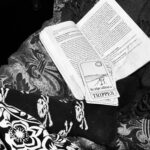7/6/23 Thursday
Yoga Sutra 4.18
sada jnatah chitta vrittayah tat prabhu purusasya aparinamitvata
|
Consciousness is witness of the mind: The activities of the mind are always known by the pure consciousness, because that pure consciousness is superior to, support of, and master over the mind.
https://www.swamij.com/yoga-sutras-41821.htm
Yoga Sutra 4.19
na tat svabhasam drishyatvat
That mind is not self-illuminating, as it is the object of knowledge and perception by the pure consciousness.
- na = is not
- tat = it
- svabhasam = self illuminating (sva = own; abhasa = illumination)
- drishyatvat = knowability
Mind is not self-illuminating: Mind is not self illuming because it is made of stuff (the three gunas), just like the photos are made of ink (of three kinds). Mind is made of the three gunas (4.13), and is not, in itself, consciousness. Rather, consciousness (purusha) operates through the mind.
| Mind is witnessed by consciousness: When the consciousness (purusha) operates through the mind, it is also witness of the mind.
Mind is the object being witnessed: When consciousness (purusha) is witnessing the mind, the mind is the object being witnessed. This is a key point here, so that this is not mere philosophy, but a practical part of the subtlest meditation processes. At some point, the mind itself is seen as an object of observation to be set aside with non-attachment, just like the many surface level thought patterns of daily life are set aside in the earlier or grosser stages of meditation. Now, the instrument of thinking itself is being seen and transcended in the pursuit of the direct experience of pure consciousness. Yoga Sutra 4.20eka-samaye cha ubhaye anavadharanam Nor can both the mind and the illuminating process be cognized simultaneously Awareness of mind and witness don’t coexist: It is not possible to be aware of an object in the mind field at the same time there is awareness of one’s true nature as the illuminator of the mind. Two things can not be in one place. If you are the witness it is the consiousness observing the mind as object. |
Yoga Sutra 4.21
chitta antara drishye buddhi-buddheh atiprasangah smriti sankarah cha
If one mind were illumined by another, as its master, then there would be an endless and absurd progression of cognitions, as well as confusion.
- chitta = of the mind, of the consciousness of the mind-field
- antara = another
- drishye = seen, perceived
- buddhi-buddheh = knower of knowledge, perceiver of perception
- atiprasangah = endless, abundance, ad infinitum
- smriti = memory, remembering
- sankarah = confusion
- cha = and
| There is no endless chain of minds: If one mind were illumined by another, as its master, then there would be an endless and absurd progression of cognitions, as well as confusion.
The Yogi seeks only pure consciousness: Since the mind is not self-illuminating, and there is not endless chain of minds, the Yogi seeks only to have the direct experience of the pure consciousness or purusha (1.3). |
https://www.swamij.com/yoga-sutras-41821.htm
The Yogi is seeking the illumination and direct experience from pure consciousness or universal light it is being filtered through the mind and its perceptions. The mind can not recognize itself and be a witness to itself.
Today I have worked on the sutras through Swami J and his website. He categorizes and explains the yoga sutras very concisely.




